 KISS ME DEADLY
KISS ME DEADLYMandrake is Mandrake
Alessandro Mercuri __ April 29, 2013
<> PDF
"In front of the cave mouth a wealth of poppies flourish, and innumerable herbs, from whose juices dew-wet Night gathers sleep, and scatters it over the darkened earth."
— Ovid, The Metamorphoses, year 1
"I'm not a magician, I'm a mentalist."
— Sean McGinly, The Great Buck Howard, 2008
Born under the pencil, the pen, the ink, and the etching, a torrent of magic appears in 1934 under the name of Mandrake the Magician. The character wears a classic and chic costume of music hall magician with a cape, a wand, a thin moustache and a top hat. Emanation from the soul of the writer, director, producer and comic strip author Lee Falk, Mandrake the Magician is published as comic strips in the daily press by the King Feature Syndicate, distribution union and exclusive property of the mogul, media tycoon: William Randolph Hearst.
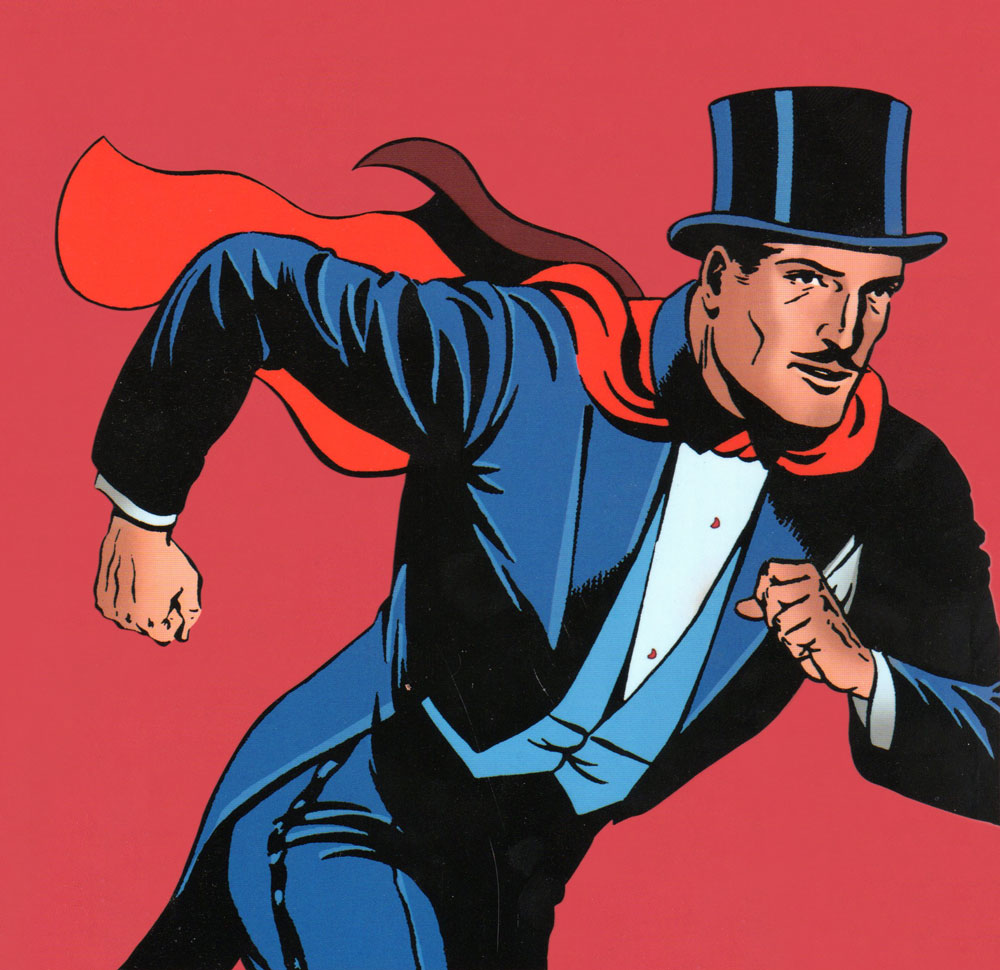
Mandrake the Magician © King Features Syndicate - Courtesy King Features Syndicate
Hearst the billionaire lives in the Hearst Castle, built on top of the Cuesta Encantada, the Enchanted Hill, bordering the Pacific Ocean on the Californian coast. It looks like the sunken Atlantis, recovered in the clouds. Hearst built a ghost town, a magical palace with Roman temple, Iberian baroque church, diamond watchtowers, Caracalla Baths in rococo style. In one of the many gardens, a white tiger smells a precious plant inside a crystal greenhouse.
From the top of his castle, lying at the edge of the Neptune pool, Hearst is stunned by his discovery of the adventures of Mandrake. The magician's name comes from a plant. Mandrake is the mandrake. A solanaceae plant rich in alkaloid, the flowers, fruits, leaves, and branches of the mandrake have highly hallucinogenic properties. A legend says that the mandrake only grows where the semen of a hanged man touched the ground. Nevertheless, Mandrake, however, was born in 1934 and fights against the evil with his hypnotic powers.
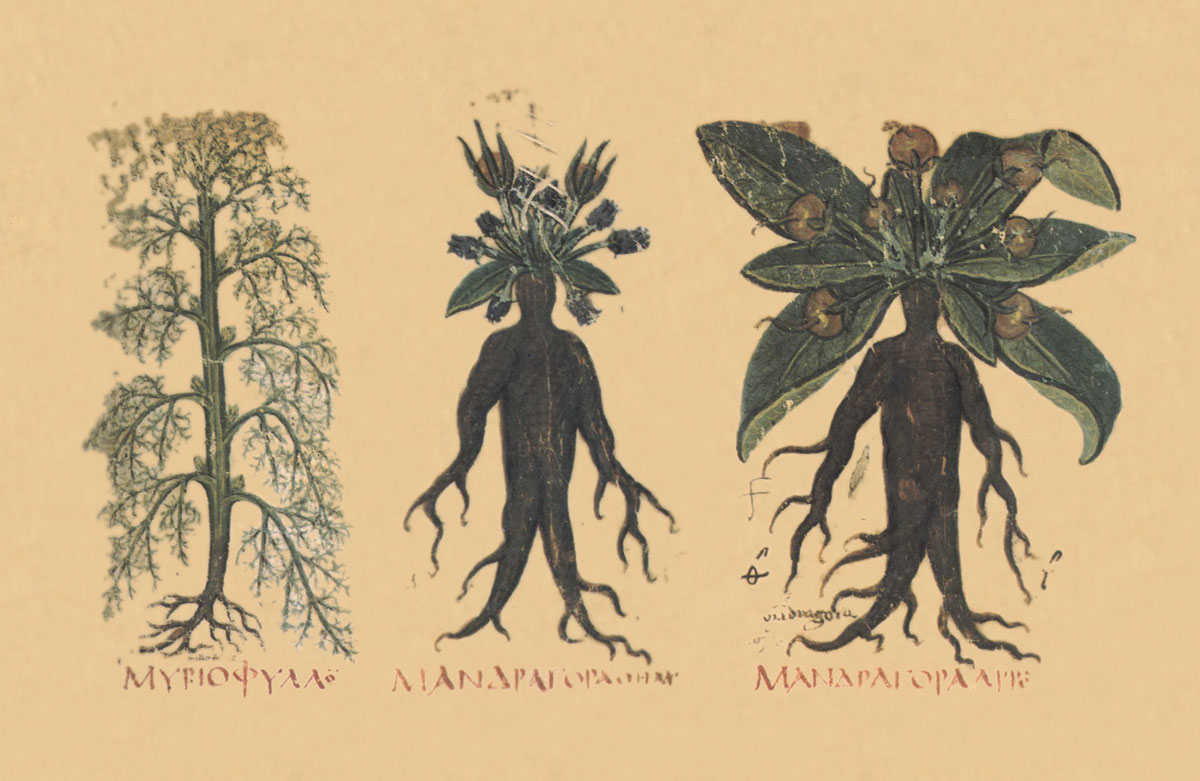
Mandrake, the plant, in Dioscurides De Materia Medica (7th century)
But two years later, Hearst starts a fierce war against marijuana, making this drug illegal as soon as 1937 through the Marihuana Tax Act. In reality, Hearst's campaign against drug addiction is not motivated by an issue of public health and morals. The prohibition of drug consumption is only a remote target. Its true purpose is to wipe out the hemp culture, significant economic threat in the paper pulp manufacturing industry. In fact, Hearst's media empire goes hand in hand with a forestry and paper manufacturing industry empire. The book has its roots in the trees. The essence of the Bible lies in the paper. The Bible comes from the Greek Byblos, Phoenician city, which was the main source of Greek import of papyrus, both the plant and the paper. The Bible is Lebanese. Located on the edge of the Mediterranean Sea, the papyrus city is today called Jbeil in Lebanon.
While Mandrake travels the world, the most exotic countries, the most distant jungles, in the company of his faithful friend Lothar, Prince of the 7 Nations, confederation of African tribes, a Leon Mandrake, however, performs on the biggest American music hall stages, and since 1922, which is more than ten years before the birth of the Mandrake character.
Magician, illusionist, mentalist, manipulator, ventriloquist, and sometimes fire-eater, Leon Mandrake, the true Mandrake, in flesh, looks exactly like the fictional Mandrake, in ink and paper. But maybe the contrary is truer. There are therefore two Mandrake(s), living in two dimensions: the real and the imaginary, the magic, the real and supernatural magic, as incredible as it might be, and the illusion, the show.
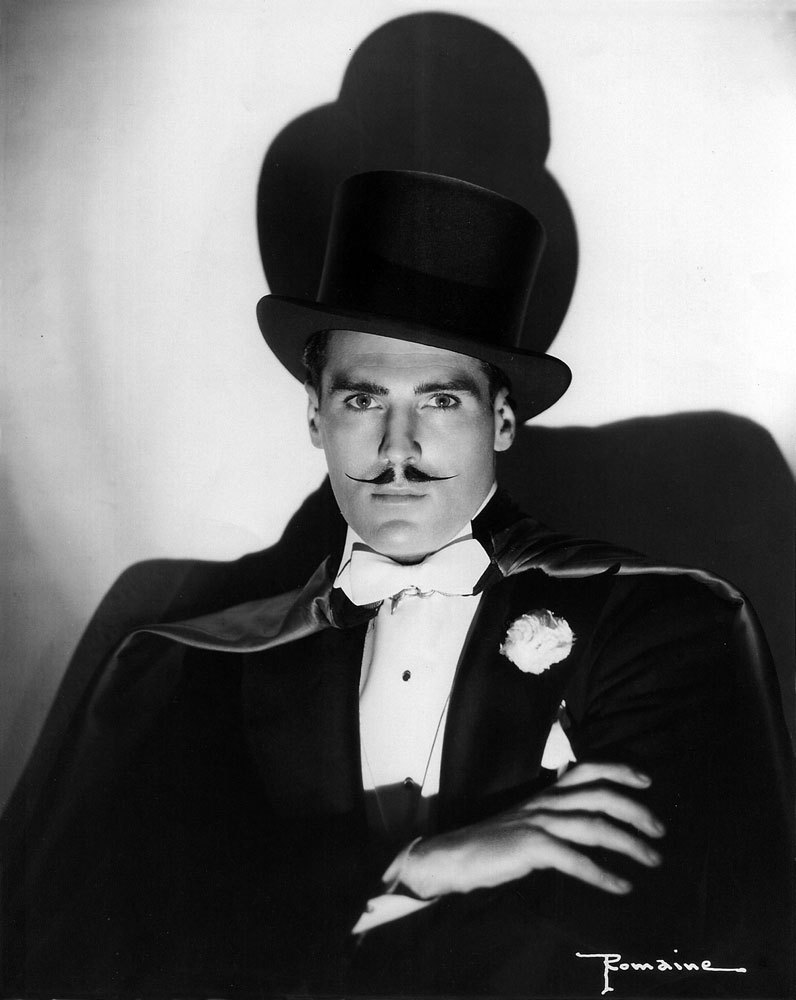
Leon Mandrake (1942) Lon Mandrake Collection - Courtesy Lon Mandrake
The magic is at the origin of the great fictional and spectacular illusion of the 20th century: cinema. 1904, screening of the movie Les cartes vivantes, from Georges Méliès. Méliès is this director from the origins, about whom Jean-Luc Godard said that he directed documentaries, on the contrary to the Lumière brothers, who staged fictions. Reality of the illusion. Fiction of the reality. Prior to his cinematographic inventions, Méliès, founder of the Academy of magic, was also recognized as a master illusionist, performing his shows on the stage of the Robert Houdin theater, named after the famous magician, master in "great illusions": living legend of magic in the 19th century. For Méliès, the cinema is the extension of the magic by other means.
In his movie "Les cartes vivantes", on a theater stage, a magician makes Judith the Queen of Hearts arise from a playing card. Similar to a retinal detachment, where the photosensitive membrane splits away from the eye-ball, the picture printed on the card, with a flower in its hand, splits away from its support. The picture of the Queen becomes flesh. The first, Georges Méliès transforms conjuring tricks, sleight of hands, tricks into special effects, and changes the magician show into a fictional movie.

Les cartes vivantes - Georges Méliès (1904)
In 1939, Columbia Pictures produce a set of B-series films on a small budget: Mandrake the Magician. The movie version seems to be the synthesis of the two characters. Here, the superhero with dark powers uses supernatural magic to defeat the evil, but also uses the illusion to perform on stage. The actor Warren Hull plays a Mandrake being both a magician-sorcerer with superpowers and, as Leon Mandrake, a music hall artist. The ambivalence of the character, the magical ambiguity is not the least of its charms.
But one year earlier, already, in 1938, while his reputation is steadily growing, Mandrake the comics’ character goes to Hollywood. In the episode entitled Mandrake in Hollywood , the dandy with a moustache is invited to Los Angeles by major film producers in order to play his own character in a set of movies on his incredible adventures. Will Mandrake be able to play Mandrake in front of the camera? The magician shoots a first screen test with a blond starlet, young actress called Marilyn Dawn. The stage director is preparing to direct Mandrake in his first role and gives him acting instructions:
NOW -- YOU'RE IN LOVE WITH THIS GIRL, MANDRAKE. YOU HAVEN'T SEEN HER FOR MONTHS! YOU COME IN THE ROOM -- AND GIVE HER A BIG KISS! OKAY -- LET'S TRY IT.
Silence on the stage. Close-up on the two lovers interlaced under the light of the headlights and in the shadow of the silver, chrome microphone recording the whisperings from their lips. The performance of the magician is far from convincing the filmmaker who yells:
NAW--NAW-- NOT THAT WAY! YOU'VE GOT TO PUT SOME FEELING INTO IT. MAKE IT LOOK LIKE YOU MEANT IT! NOW--LET'S TRY IT AGAIN-- AND MAKE IT HOT!
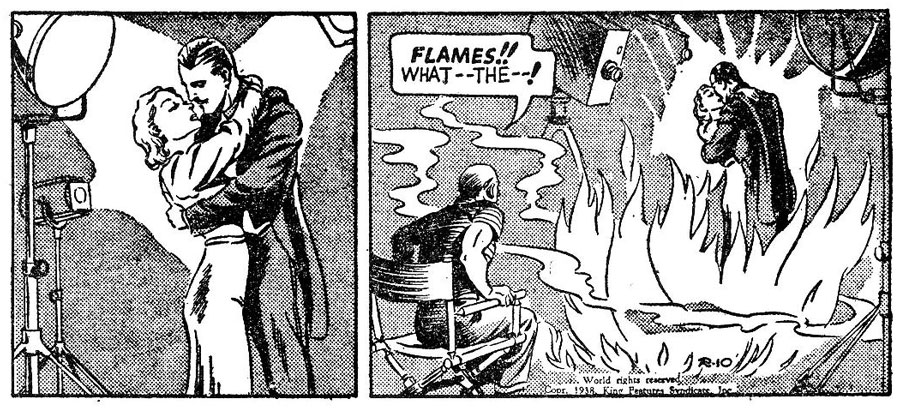
Mandrake in Hollyhood (1938) © King Features Syndicate - Courtesy King Features Syndicate
The scene resumes when suddenly, everything sets to flames and blazes around the embrace of the two lovers. Stunned, the director looks at the hugging couple through a glowing red and whitish screen of flames and smoke. The special effects are an extension of the metaphor. The passion of the kiss is literally incandescent. The director asks for more and wants to immortalize a new magic trick.
The director:
- NOW, MANDRAKE. I WANT YOU TO DO ONE OF YOUR TRICKS FOR THE CAMERA.
Mandrake:
- I'M AFRAID I CAN'T FOOL THE CAMERA WITHOUT TRICK APPARATUS.
The director:
- BUT I'VE SEEN YOU TURN A MOUSE INTO AN ELEPHANT AND -- DO YOU MEAN TO SAY YOU CAN HYPNOTIZE A WHOLE ROOMFUL OF PEOPLE---
And the speech bubble continuing in the lower left box:
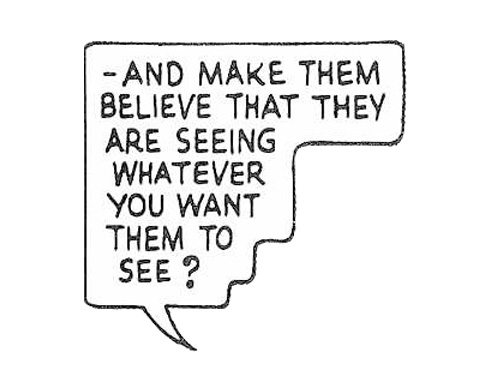
Admirable idiom that this make believe that unites the power of making and the action of believing as to suggest the magnitude of the illusion in any thing.
Make believe is to magic that make love is to sex. Belief and feeling are embodied, flourished and realized in the make. If the faith is belief , the magic, however, is make belief, the belief in the making, in the becoming. But the spirit of censorship, prudish and conceptual, is watchful. Because the make belief operates in troubled waters in a spectacular and deceptive space, made of lies, illusions, where dissimulation and simulation reach marvels. The line is decidedly blurred between the conjurer, the impostor, the manipulator, the illusionist, the prestidigitator, the magician, and the charlatan. The imaginary becomes real, the impossible becomes possible and the conjuring becomes magic. We "widen our eyes", we "cannot believe our ears". But could there only be make belief , without this irrepressible willingness to believe, this secret desire to be deceived, this intimate desire to be transported, possessed, delighted, by the magic? Magical levitation of the spirit weightlessly navigating in the imaginary.
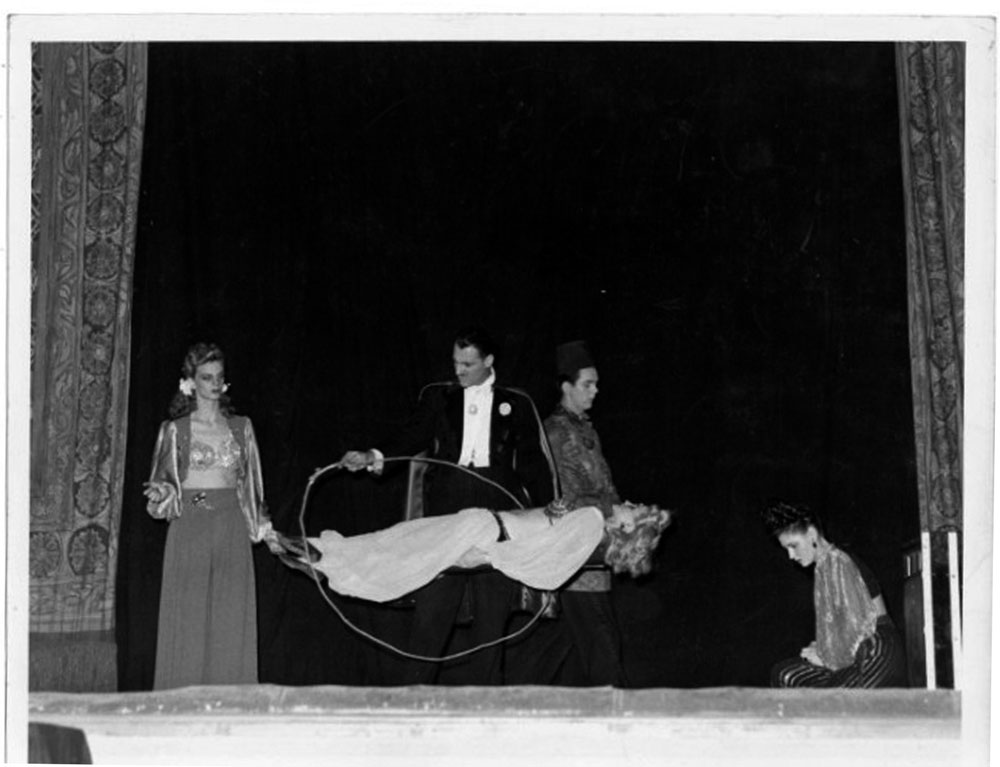
Leon Mandrake on stage - Lon Mandrake Collection - Courtesy Lon Mandrake
Thanks to the magic show, the audience plunges back in the primitive waters of archaic, pre-logical, non-discursive thinking called magic. Before it appears, defying the laws of logic, the rabbit may be both in the hat and elsewhere, in the depths of the black felt hat and in another place, in wonderland or between the swift fingers, nimble fingers of the presti-digitator. It is with the magic rabbit of the illusionist as with the Schrödinger quantum cat which can be both dead and alive without ever being a living dead. The magic operates as in a dream where a vision may mean one thing and its contrary. Ancestral magic as in the archaic languages, such as the Egyptian where a hieroglyph such as the word light is used both to designate light and darkness. [1]
The magic updates the alchemical performance of transmutation of the beings: multicolored scarves into white doves, white mouse into pink elephant, or any transformation of a physical object into a mental, hallucinatory picture. MAGIc = IMAGe. The swap of a single letter and voila!, and the curtain and the music rise into the air:
That old black magic has me in its spell
That old black magic that you weave so well
Those icy fingers up and down my spine
The same old witchcraft when your eyes meet mine [2]
Similar to a sensual and voyeuristic show, a peep show or strip tease, the magic trick is this moment of intense contemplative seduction. And the more it lingers, the more unlikely the show becomes, and the incredible becomes credible. Stripping of an endless mystery, daydream, under the spell of the magic, the audience is bewitched, hypnotized, amazed, stunned, magnetized, mesmerized.
Mandrake :
- MASS HYPNOTISM IS NOT NEW. INDIAN MAGICIANS HAVE BEEN DOING IT FOR CENTURIES, BUT YOU CAN'T HYPNOTIZE A CAMERA.
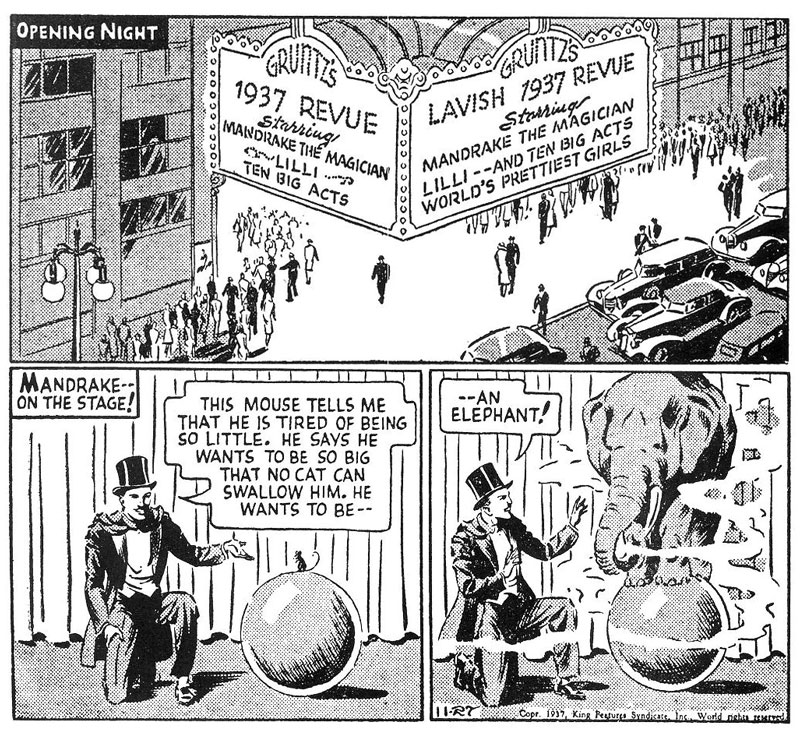
Mandrake in America (1937) © King Features Syndicate - Courtesy King Features Syndicate
Let's summarize the words of Mandrake. With Mandrake, no need for tricks, riggings, or special effects, no need for double bottoms and one-way mirrors because his art, his magic, are based on hypnosis. To turn a mouse into an elephant, no need for a mouse or an elephant. Whether the performance occurs in a Hollywood film studio or in the heart of a mysterious and impenetrable African, Indian, or South American jungle, when Mandrake performs, Mandrake "mandrakes", for fake or for real, for the entertainment or to preserve the civilization from dangerous psychopaths, scientists, or gurus successfully practicing black magic themselves, whether Mandrake performs as a movie actor or as the savior of mankind, Mandrake always hypnotize. Only the camera shall resist. "You cannot hypnotize a camera", he says.

The Octopus Ring (1940) © King Features Syndicate - Courtesy King Features Syndicate
The lens cannot see the illusion because what Mandrake shows us is "reverse cinema". While the camera records the real to screen fantasy, Mandrake projects into the minds of the audience a hallucination which cannot be recorded. The intense visibility of the hallucination remains invisible to the camera. Once the film roll is developed and the scene is screened in a theater, the unbelievable happens: nothing happens. No magic, no flame, no elephant, no mouse. The film roll cannot show what the audience thought they saw. By a strange inversion, the spectacular magic, the hypnotic image is in fact invisible.

Leon Mandrake - Lon Mandrake Collection - Courtesy Lon Mandrake
Mandrake the fictional hypnotist magician, as well as Leon Mandrake-the prestidigitator, the real magician, both make us believe by pretending: make-believe. The disappointment will be great and the Hollywood film career of the fictional magician will be short. But Mandrake is already gone after new adventures.
The love affair between the magician and the fictional actress Marylin Dawn is already just a mere memory and a few months later in this same year 1937, while the U.S. Senate votes the bill of the Federal Bureau of Narcotics, the Marihuana Tax Act , Mandrake the comic strips magician marries with Princess Narda. The Princess comes from the kingdom of Cockaigne. In other words, imaginary. Narda does not exist. Narda is also a fictional character.

Princess Narda and her doves - Lon Mandrake Collection - Courtesy Lon Mandrake
But, by the strangest of mysteries, Narda is also the name of the first wife of Leon Mandrake, the true magician. In the fiction, the wedding ceremony takes place at Xanadu, high-tech residence where Mandrake, the comic strips character, likes to relax. Xanadu is a futuristic ultra-design, supra-sophisticated, hyper-secure residence, with wrought iron gates and steel shutters, which is automated, camera-monitored, lined with electronic gadgets, bunkerized. As the author of 2001: A Space Odyssey, Arthur C. Clarke, wrote: Any sufficiently advanced technology is indistinguishable from magic. Does the paranoia lurk the comic book character? Would the magician with hypnotic powers also be prey to anguish, to hallucinations and splitting of personality? Whatever. Because Xanadu is also the name of the residence of Charles Foster Kane, the Citizen Kane of Orson Welles (1941). Kane lives in Xanadu, Hearst lives in La Cuesta Encantada. Nothing more natural since the well-known role-model of Charles Foster Kane is William Randolph Hearst. Orson Welles, who also indulged in the art of magic, knew how to change in a wave of his wand the media mogul into a fictional character. And it's from the top of his castle, lying at the edge of the Neptune pool, Hearst is stunned by his discovery of the adventures of Mandrake the Magician.
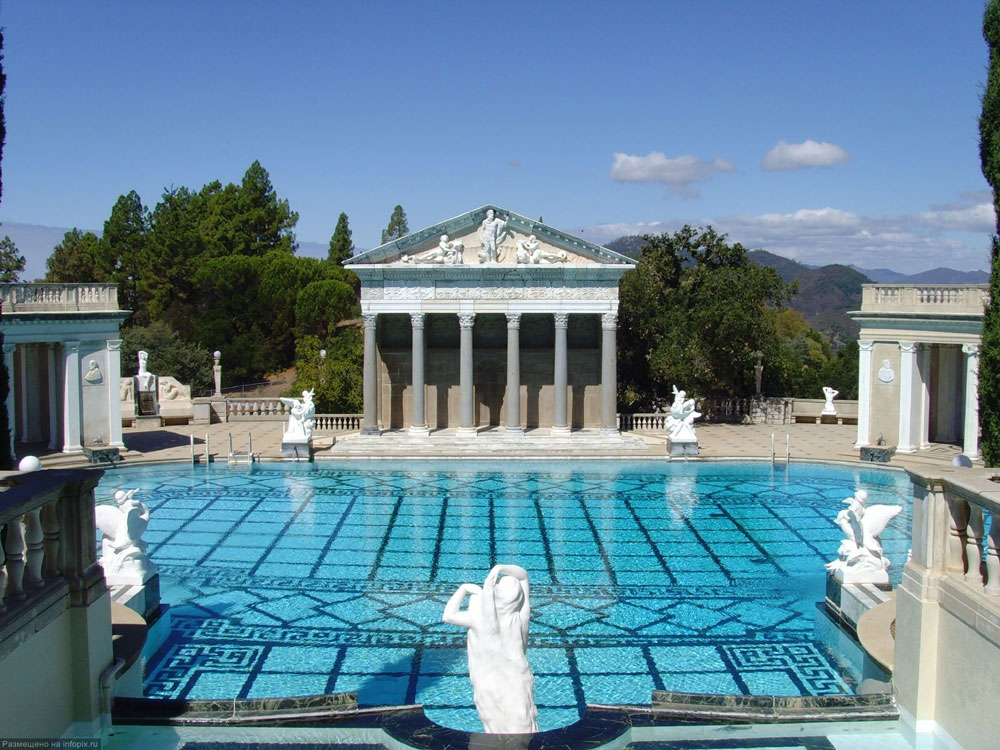
Neptune Pool, Hearst Castle, California - photography by Klaus Nahr
Today, Mandrake is recognized as the very first superhero in comic strip history. Emerging from a magic lantern, like a jinn with extrasensory skills, Mandrake reappears from nowhere, crepuscular and melancholic, in 1987, under the features of Marcello Mastrioanni in Intervista , the before last film by Federico Fellini. The actor and the director play their own character.
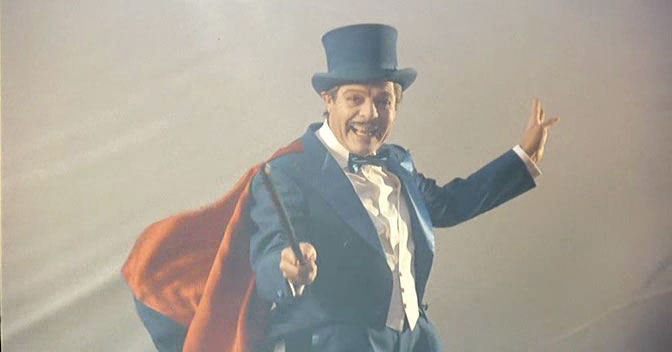
Marcello Mastroianni in Intervista - Federico Fellini (1987)
Federico Fellini:
- WHAT IS IT? WHAT'S GOING ON?
Smoke on white veil, wind noises, window opening, Mandrake appearing behind, blue and white balloons flying away.
Marcello Mastroianni :
- SEXUAL PROBLEMS? FORGET YOUR WOES! MANDRAKE'S HERE! TOW TAPS OF HIS STICK AND UP COMES YOUR DICK! HURRAY!
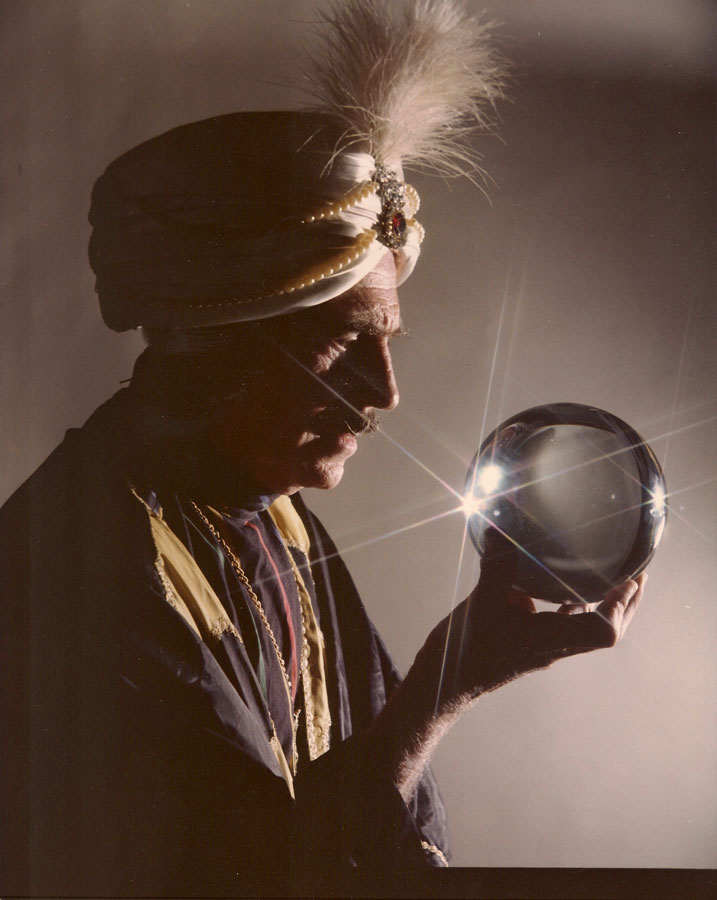
Leon Mandrake (1975) - Lon Mandrake Collection - Courtesy Lon Mandrake
Special thanks: Lon Mandrake
Translated from the French by Sarah Hudson
"In front of the cave mouth a wealth of poppies flourish, and innumerable herbs, from whose juices dew-wet Night gathers sleep, and scatters it over the darkened earth."
— Ovid, The Metamorphoses, year 1
"I'm not a magician, I'm a mentalist."
— Sean McGinly, The Great Buck Howard, 2008
Born under the pencil, the pen, the ink, and the etching, a torrent of magic appears in 1934 under the name of Mandrake the Magician. The character wears a classic and chic costume of music hall magician with a cape, a wand, a thin moustache and a top hat. Emanation from the soul of the writer, director, producer and comic strip author Lee Falk, Mandrake the Magician is published as comic strips in the daily press by the King Feature Syndicate, distribution union and exclusive property of the mogul, media tycoon: William Randolph Hearst.

Mandrake the Magician © King Features Syndicate - Courtesy King Features Syndicate
Hearst the billionaire lives in the Hearst Castle, built on top of the Cuesta Encantada, the Enchanted Hill, bordering the Pacific Ocean on the Californian coast. It looks like the sunken Atlantis, recovered in the clouds. Hearst built a ghost town, a magical palace with Roman temple, Iberian baroque church, diamond watchtowers, Caracalla Baths in rococo style. In one of the many gardens, a white tiger smells a precious plant inside a crystal greenhouse.
From the top of his castle, lying at the edge of the Neptune pool, Hearst is stunned by his discovery of the adventures of Mandrake. The magician's name comes from a plant. Mandrake is the mandrake. A solanaceae plant rich in alkaloid, the flowers, fruits, leaves, and branches of the mandrake have highly hallucinogenic properties. A legend says that the mandrake only grows where the semen of a hanged man touched the ground. Nevertheless, Mandrake, however, was born in 1934 and fights against the evil with his hypnotic powers.

Mandrake, the plant, in Dioscurides De Materia Medica (7th century)
But two years later, Hearst starts a fierce war against marijuana, making this drug illegal as soon as 1937 through the Marihuana Tax Act. In reality, Hearst's campaign against drug addiction is not motivated by an issue of public health and morals. The prohibition of drug consumption is only a remote target. Its true purpose is to wipe out the hemp culture, significant economic threat in the paper pulp manufacturing industry. In fact, Hearst's media empire goes hand in hand with a forestry and paper manufacturing industry empire. The book has its roots in the trees. The essence of the Bible lies in the paper. The Bible comes from the Greek Byblos, Phoenician city, which was the main source of Greek import of papyrus, both the plant and the paper. The Bible is Lebanese. Located on the edge of the Mediterranean Sea, the papyrus city is today called Jbeil in Lebanon.
While Mandrake travels the world, the most exotic countries, the most distant jungles, in the company of his faithful friend Lothar, Prince of the 7 Nations, confederation of African tribes, a Leon Mandrake, however, performs on the biggest American music hall stages, and since 1922, which is more than ten years before the birth of the Mandrake character.
Magician, illusionist, mentalist, manipulator, ventriloquist, and sometimes fire-eater, Leon Mandrake, the true Mandrake, in flesh, looks exactly like the fictional Mandrake, in ink and paper. But maybe the contrary is truer. There are therefore two Mandrake(s), living in two dimensions: the real and the imaginary, the magic, the real and supernatural magic, as incredible as it might be, and the illusion, the show.

Leon Mandrake (1942) Lon Mandrake Collection - Courtesy Lon Mandrake
The magic is at the origin of the great fictional and spectacular illusion of the 20th century: cinema. 1904, screening of the movie Les cartes vivantes, from Georges Méliès. Méliès is this director from the origins, about whom Jean-Luc Godard said that he directed documentaries, on the contrary to the Lumière brothers, who staged fictions. Reality of the illusion. Fiction of the reality. Prior to his cinematographic inventions, Méliès, founder of the Academy of magic, was also recognized as a master illusionist, performing his shows on the stage of the Robert Houdin theater, named after the famous magician, master in "great illusions": living legend of magic in the 19th century. For Méliès, the cinema is the extension of the magic by other means.
In his movie "Les cartes vivantes", on a theater stage, a magician makes Judith the Queen of Hearts arise from a playing card. Similar to a retinal detachment, where the photosensitive membrane splits away from the eye-ball, the picture printed on the card, with a flower in its hand, splits away from its support. The picture of the Queen becomes flesh. The first, Georges Méliès transforms conjuring tricks, sleight of hands, tricks into special effects, and changes the magician show into a fictional movie.

Les cartes vivantes - Georges Méliès (1904)
In 1939, Columbia Pictures produce a set of B-series films on a small budget: Mandrake the Magician. The movie version seems to be the synthesis of the two characters. Here, the superhero with dark powers uses supernatural magic to defeat the evil, but also uses the illusion to perform on stage. The actor Warren Hull plays a Mandrake being both a magician-sorcerer with superpowers and, as Leon Mandrake, a music hall artist. The ambivalence of the character, the magical ambiguity is not the least of its charms.
But one year earlier, already, in 1938, while his reputation is steadily growing, Mandrake the comics’ character goes to Hollywood. In the episode entitled Mandrake in Hollywood , the dandy with a moustache is invited to Los Angeles by major film producers in order to play his own character in a set of movies on his incredible adventures. Will Mandrake be able to play Mandrake in front of the camera? The magician shoots a first screen test with a blond starlet, young actress called Marilyn Dawn. The stage director is preparing to direct Mandrake in his first role and gives him acting instructions:
NOW -- YOU'RE IN LOVE WITH THIS GIRL, MANDRAKE. YOU HAVEN'T SEEN HER FOR MONTHS! YOU COME IN THE ROOM -- AND GIVE HER A BIG KISS! OKAY -- LET'S TRY IT.
Silence on the stage. Close-up on the two lovers interlaced under the light of the headlights and in the shadow of the silver, chrome microphone recording the whisperings from their lips. The performance of the magician is far from convincing the filmmaker who yells:
NAW--NAW-- NOT THAT WAY! YOU'VE GOT TO PUT SOME FEELING INTO IT. MAKE IT LOOK LIKE YOU MEANT IT! NOW--LET'S TRY IT AGAIN-- AND MAKE IT HOT!

Mandrake in Hollyhood (1938) © King Features Syndicate - Courtesy King Features Syndicate
The scene resumes when suddenly, everything sets to flames and blazes around the embrace of the two lovers. Stunned, the director looks at the hugging couple through a glowing red and whitish screen of flames and smoke. The special effects are an extension of the metaphor. The passion of the kiss is literally incandescent. The director asks for more and wants to immortalize a new magic trick.
The director:
- NOW, MANDRAKE. I WANT YOU TO DO ONE OF YOUR TRICKS FOR THE CAMERA.
Mandrake:
- I'M AFRAID I CAN'T FOOL THE CAMERA WITHOUT TRICK APPARATUS.
The director:
- BUT I'VE SEEN YOU TURN A MOUSE INTO AN ELEPHANT AND -- DO YOU MEAN TO SAY YOU CAN HYPNOTIZE A WHOLE ROOMFUL OF PEOPLE---
And the speech bubble continuing in the lower left box:

Admirable idiom that this make believe that unites the power of making and the action of believing as to suggest the magnitude of the illusion in any thing.
Make believe is to magic that make love is to sex. Belief and feeling are embodied, flourished and realized in the make. If the faith is belief , the magic, however, is make belief, the belief in the making, in the becoming. But the spirit of censorship, prudish and conceptual, is watchful. Because the make belief operates in troubled waters in a spectacular and deceptive space, made of lies, illusions, where dissimulation and simulation reach marvels. The line is decidedly blurred between the conjurer, the impostor, the manipulator, the illusionist, the prestidigitator, the magician, and the charlatan. The imaginary becomes real, the impossible becomes possible and the conjuring becomes magic. We "widen our eyes", we "cannot believe our ears". But could there only be make belief , without this irrepressible willingness to believe, this secret desire to be deceived, this intimate desire to be transported, possessed, delighted, by the magic? Magical levitation of the spirit weightlessly navigating in the imaginary.

Leon Mandrake on stage - Lon Mandrake Collection - Courtesy Lon Mandrake
Thanks to the magic show, the audience plunges back in the primitive waters of archaic, pre-logical, non-discursive thinking called magic. Before it appears, defying the laws of logic, the rabbit may be both in the hat and elsewhere, in the depths of the black felt hat and in another place, in wonderland or between the swift fingers, nimble fingers of the presti-digitator. It is with the magic rabbit of the illusionist as with the Schrödinger quantum cat which can be both dead and alive without ever being a living dead. The magic operates as in a dream where a vision may mean one thing and its contrary. Ancestral magic as in the archaic languages, such as the Egyptian where a hieroglyph such as the word light is used both to designate light and darkness. [1]
The magic updates the alchemical performance of transmutation of the beings: multicolored scarves into white doves, white mouse into pink elephant, or any transformation of a physical object into a mental, hallucinatory picture. MAGIc = IMAGe. The swap of a single letter and voila!, and the curtain and the music rise into the air:
That old black magic has me in its spell
That old black magic that you weave so well
Those icy fingers up and down my spine
The same old witchcraft when your eyes meet mine [2]
Similar to a sensual and voyeuristic show, a peep show or strip tease, the magic trick is this moment of intense contemplative seduction. And the more it lingers, the more unlikely the show becomes, and the incredible becomes credible. Stripping of an endless mystery, daydream, under the spell of the magic, the audience is bewitched, hypnotized, amazed, stunned, magnetized, mesmerized.
Mandrake :
- MASS HYPNOTISM IS NOT NEW. INDIAN MAGICIANS HAVE BEEN DOING IT FOR CENTURIES, BUT YOU CAN'T HYPNOTIZE A CAMERA.

Mandrake in America (1937) © King Features Syndicate - Courtesy King Features Syndicate
Let's summarize the words of Mandrake. With Mandrake, no need for tricks, riggings, or special effects, no need for double bottoms and one-way mirrors because his art, his magic, are based on hypnosis. To turn a mouse into an elephant, no need for a mouse or an elephant. Whether the performance occurs in a Hollywood film studio or in the heart of a mysterious and impenetrable African, Indian, or South American jungle, when Mandrake performs, Mandrake "mandrakes", for fake or for real, for the entertainment or to preserve the civilization from dangerous psychopaths, scientists, or gurus successfully practicing black magic themselves, whether Mandrake performs as a movie actor or as the savior of mankind, Mandrake always hypnotize. Only the camera shall resist. "You cannot hypnotize a camera", he says.

The Octopus Ring (1940) © King Features Syndicate - Courtesy King Features Syndicate
The lens cannot see the illusion because what Mandrake shows us is "reverse cinema". While the camera records the real to screen fantasy, Mandrake projects into the minds of the audience a hallucination which cannot be recorded. The intense visibility of the hallucination remains invisible to the camera. Once the film roll is developed and the scene is screened in a theater, the unbelievable happens: nothing happens. No magic, no flame, no elephant, no mouse. The film roll cannot show what the audience thought they saw. By a strange inversion, the spectacular magic, the hypnotic image is in fact invisible.

Leon Mandrake - Lon Mandrake Collection - Courtesy Lon Mandrake
Mandrake the fictional hypnotist magician, as well as Leon Mandrake-the prestidigitator, the real magician, both make us believe by pretending: make-believe. The disappointment will be great and the Hollywood film career of the fictional magician will be short. But Mandrake is already gone after new adventures.
The love affair between the magician and the fictional actress Marylin Dawn is already just a mere memory and a few months later in this same year 1937, while the U.S. Senate votes the bill of the Federal Bureau of Narcotics, the Marihuana Tax Act , Mandrake the comic strips magician marries with Princess Narda. The Princess comes from the kingdom of Cockaigne. In other words, imaginary. Narda does not exist. Narda is also a fictional character.

Princess Narda and her doves - Lon Mandrake Collection - Courtesy Lon Mandrake
But, by the strangest of mysteries, Narda is also the name of the first wife of Leon Mandrake, the true magician. In the fiction, the wedding ceremony takes place at Xanadu, high-tech residence where Mandrake, the comic strips character, likes to relax. Xanadu is a futuristic ultra-design, supra-sophisticated, hyper-secure residence, with wrought iron gates and steel shutters, which is automated, camera-monitored, lined with electronic gadgets, bunkerized. As the author of 2001: A Space Odyssey, Arthur C. Clarke, wrote: Any sufficiently advanced technology is indistinguishable from magic. Does the paranoia lurk the comic book character? Would the magician with hypnotic powers also be prey to anguish, to hallucinations and splitting of personality? Whatever. Because Xanadu is also the name of the residence of Charles Foster Kane, the Citizen Kane of Orson Welles (1941). Kane lives in Xanadu, Hearst lives in La Cuesta Encantada. Nothing more natural since the well-known role-model of Charles Foster Kane is William Randolph Hearst. Orson Welles, who also indulged in the art of magic, knew how to change in a wave of his wand the media mogul into a fictional character. And it's from the top of his castle, lying at the edge of the Neptune pool, Hearst is stunned by his discovery of the adventures of Mandrake the Magician.

Neptune Pool, Hearst Castle, California - photography by Klaus Nahr
Today, Mandrake is recognized as the very first superhero in comic strip history. Emerging from a magic lantern, like a jinn with extrasensory skills, Mandrake reappears from nowhere, crepuscular and melancholic, in 1987, under the features of Marcello Mastrioanni in Intervista , the before last film by Federico Fellini. The actor and the director play their own character.

Marcello Mastroianni in Intervista - Federico Fellini (1987)
Federico Fellini:
- WHAT IS IT? WHAT'S GOING ON?
Smoke on white veil, wind noises, window opening, Mandrake appearing behind, blue and white balloons flying away.
Marcello Mastroianni :
- SEXUAL PROBLEMS? FORGET YOUR WOES! MANDRAKE'S HERE! TOW TAPS OF HIS STICK AND UP COMES YOUR DICK! HURRAY!

Leon Mandrake (1975) - Lon Mandrake Collection - Courtesy Lon Mandrake
Special thanks: Lon Mandrake
Translated from the French by Sarah Hudson
TAGS : Mandrake the Magician, Lee Falk, King Feature Syndicate, William Randolph Hearst, Hearst Castle, La Cuesta Encantada, Neptune pool, mandrake, hypnotic powers, Marihuana Tax Act, Bible, Byblos, Jbeil, Lothar, Leon Mandrake, Lon Mandrake, magician, illusionist, mentalist, manipulator, ventriloquist, fire-eater, magic, cinema, Les cartes vivantes, Georges Méliès, Jean-Luc Godard, Académie de Prestidigitation, Robert Houdin theater, great illusions, conjuring tricks, sleight of hands, tricks, special effects, Columbia Pictures, Warren Hull, Hollywood, Mandrake in Hollywood, Marylin Dawn, make believe, Mandrake in America, The Octopus Ring, Princess Narda, Narda, Xanadu, 2001: A Space Odyssey, Arthur C. Clarke, Charles Foster Kane, Citizen Kane, Orson Welles, jinn, Marcello Mastroianni, Intervista, Federico Fellini.
NEXT POST >>










